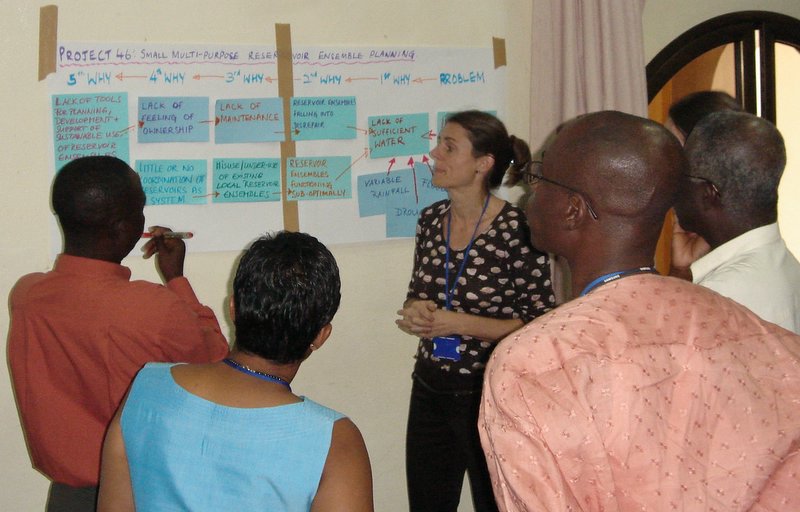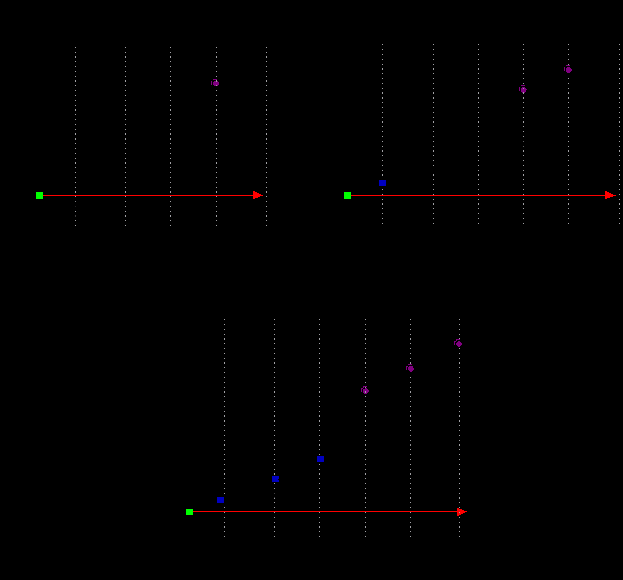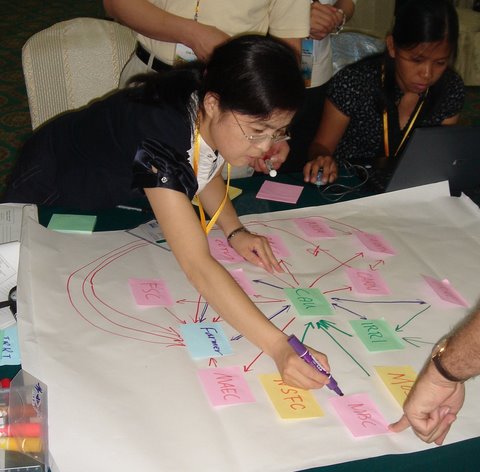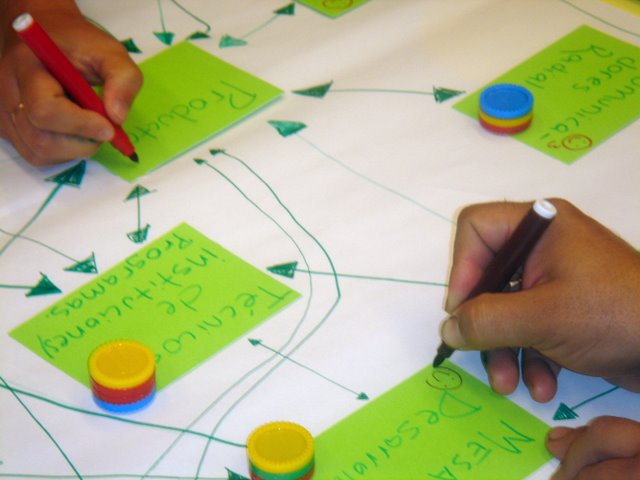PARTICIPATORY IMPACT PATHWAYS ANALYSIS A PRACTICAL METHOD FOR PROJECT
ABSTRACT FARMERPARTICIPATORY RESEARCH (FPR) CAN HELP IMPROVE THE EFFECTIVENESSADDITIONAL FILE PARTICIPATORY RURAL APPRAISAL (PRA) FOCUS GROUP FACILITATOR’S
GRASSROOTS MAPPING CREATING A PARTICIPATORY MAPMAKING PROCESS CENTERED ON
IDP PARTICIPATORY ASSESSMENT FEBRUARY 2016 SULAYMANIYAH— KRI BACKGROUND AND
INTO THE DREAMING OF EARTH A YEARLONG PARTICIPATORY IMMERSION
JADWAL PELATIHAN KULIAH KERJA NYATA TRANSFORMATIF PENDEKATAN PARTICIPATORY ACTION
Participatory Impact Pathways Analysis: A Practical Method for Project Planning and Evaluation
Participatory Impact Pathways Analysis: a practical method for project planning and evaluation
Boru Douthwaite, Sophie Alvarez, Graham Thiele and Ronald Mackay
January, 2008
Abstract
Participatory Impact Pathways Analysis (PIPA) is a practical planning, and monitoring and evaluation approach developed for use with complex projects in the water and food sectors. PIPA begins with a participatory workshop where stakeholders make explicit their assumptions about how their project will achieve an impact. Participants construct problem trees, carry out a visioning exercise and draw network maps to help them clarify their ‘impact pathways’. These are then articulated in two logic models. The outcomes logic model describes the project’s medium term objectives in the form of hypotheses: which actors need to change, what are those changes and which strategies are needed to realise these changes. The impact logic model describes how, by helping to achieve the expected outcomes, the project will impact on people’s livelihoods. Participants derive outcome targets and milestones which are regularly revisited and revised as part of project monitoring and evaluation (M&E). PIPA goes beyond the traditional use of logic models and logframes by engaging stakeholders in a structured participatory process, promoting learning and providing a framework for ‘action research’ on processes of change.
Introduction
Project evaluation is currently used to: 1) communicate to donors the expected and actual impacts of the project; 2) show compliance with the agreed work plan, and negotiate changes to it; and 3) provide systematic information to support learning and decision making during the implementation of the project. Participatory Impact Pathways Analysis1 (PIPA) improves evaluation by allowing managers and staff to formalize their project’s impact pathways and to monitor progress, encouraging reflection, learning and adjustment along the way. Impact pathways are the detailed assumptions and hypotheses about how a project is expected to achieve its goal. They describe how individuals and organisations should act differently, strategies to bring this about, and how such change might impact on peoples’ livelihoods.
Evaluators generally agree that it is good practice to first formalize a project’s impact pathways, and then evaluate the project against this ‘logic model” (e.g. Chen, 2005). In the CGIAR planning system, logic models are called ‘logical frameworks’, or ‘logframes’ for short. PIPA goes beyond the traditional use of logframes by: 1) involving key stakeholders in a joint process; 2) emphasizing the stakeholder networks needed to achieve impact; 3) providing the information managers need both to learn and to report to their donors; and 4) establishing a research framework to examine the critical processes of change that projects seek to initiate and sustain.
Development and use of PIPA
PIPA grew out of ILAC funded work by the International Center for Tropical Agriculture (CIAT – Spanish acronym) on innovation histories (Douthwaite and Ashby, 2005) and work to evaluate impact pathways in an integrated weed management project in Nigeria (Douthwaite et al., 2003 and 2007). It was first used in a workshop in January 2006 when seven project teams, funded by the Challenge Program on Water and Food (CPWF), met for three days to co-construct their respective impact pathways in order to help the CPWF better understand the types of impacts its teams were envisioning. To date, staff from 44 CPWF projects have constructed their impact pathways in seven workshops.
During 2008, PIPA will continue to be used for project planning and M&E by CPWF; by an EU-funded project in Latin America2, and by the International Potato Center (CIP - Spanish acronym) for ex-post evaluation purposes in the Andean Change Project. PIPA will also be used for ILAC’s own learning-based evaluation.
PIPA is an umbrella term to describe both the participatory construction of impact pathways and their subsequent use. This brief focuses on the participatory monitoring and evaluation of progress along impact pathways. The use of impact pathways for ex-ante impact assessment is described in Douthwaite (et al., in press). Used ex-post PIPA involves using the PIPA workshop format to reconstruct impact pathways. More information on all aspects of PIPA, including an on-line manual, can be found at http://impactpathways.pbwiki.com. PIPA is similar in its philosophy to ‘outcome mapping’ (Earl et al. 2001). A main difference is that PIPA stretches participants to predict how project outcomes can lead to social, economic and environmental impacts.
The PIPA workshop
At the heart of PIPA is a participatory workshop in which project implementers and key stakeholders construct project impact pathways. Those who have contributed to a traditional logframe know that completing the required formats is tedious in groups and is often dominated by one or two people. Our experience is that when people are not constrained, at the outset, to fill in logframe boxes, they have tremendous energy for exploring collective ideas about how a project should work, or has worked. Therefore, in the PIPA workshop, participants only attempt to create a logic model once the underlying impact pathways have been discussed and agreed.
The PIPA workshop is useful when two or more project teams in the same program wish to integrate better. At least two people for each project should attend; preferably this should include the project leader. The workshop also works well when one project team wishes to build common understanding and commitment with its stakeholders. In this case, two or more representatives from each important stakeholder group should attend. The ideal group size is four to six and the ideal number of groups is three to six. We have facilitated workshops with nine projects but this leaves little time for individual presentations and plenary, and participants tend to be overwhelmed by too much information.
Day 1: Developing a cause-and-effect logic
Participants spend most of Day 1 developing a problem tree for their project. Most people easily grasp the cause–effect logic of the problem tree, which begins with the identification of problems the project could potentially address and ends with problems that the project will directly address. When working with several projects from the same program, presentations of various problem trees help participants better understand each others’ aims, a prerequisite for successful programmatic integration.
Figure 1: Presenting a problem tree in the Volta Basin Impact Pathways Workshop

Day 2: Developing a network perspective
Problem trees are seductively simple; they can lure people into thinking that solving a limited set of discrete problems begins a domino-like cascade which automatically achieves impact. Participants generally point this danger out themselves on Day 1. Day 2, therefore, is about balancing cause-effect logic with a network perspective, in which impact results from interactions between actors in an ‘innovation system’. These interactions can be modelled by drawing network maps showing important relationships between actors.
To connect Day 1 with Day 2, participants construct a vision of success in which they imagine what the following classes of stakeholders will do differently after the project:
The users of project outputs, or ‘next users’;
Groups with whom the next users work;
Politically-important people and organizations who can help facilitate the project;
The project implementers themselves.
Next, participants draw a ‘now’ network map, showing current key relationships between stakeholders, and a ‘future’ network map showing how stakeholders should link together to achieve the vision. Participants then devise strategies to bring about the main changes. The influence and attitude of actors is explicitly considered during these exercises (see Figure 2 (ii)) based on work by Schiffer (2007).
Figure 2: Drawing network maps in a PIPA workshop
|
|
|
|
(i) Drawing a network map |
(ii) Placement of influence towers and drawing of ‘smiley’ faces to indicate stakeholder attitude to the project |
Day 3: Developing the outcomes logic model and an M&E plan
In the final part of the workshop, participants distil and integrate their cause-effect descriptions from the problem tree with the network view of project impact pathways into an outcomes logic model. This model describes in table format (see Table 1) how stakeholders (i.e. next users, end users, politically-important actors and project implementers) should act differently if the project is to achieve its vision. Each row describes changes in a particular actor’s knowledge, attitude, skills (KAS) and practice, and strategies to bring these changes about. The strategies include developing project outputs with next users and end users who subsequently employ them. The resulting changes are outcomes, hence the name of the model, which borrows in part from Bennett’s hierarchy (Bennett and Rockwell, 2000; Templeton, 2005).
Table 1: The outcomes logic model
|
Actor (or group of actors who are expected to change in the same way) |
Change in practice required to achieve the project’s vision |
Change in KAS1 required to support this change |
Project strategies2 to bring about these changes in KAS and practice? |
|
|
|
|
|
|
|
|
|
|
1 Knowledge, Attitude and Skills
2 Project strategies include developing project outputs (knowledge, technology, etc.) with stakeholders, capacity building, communication, political lobbying, etc.
The outcomes logic model is the foundation for monitoring and evaluation because it provides the outcome hypotheses, in the form of predictions, which M&E sets out to test. The predictions are that, if key assumptions are met, the envisaged project strategies will help bring about desired changes in KAS and practice of respective actors.
M&E requires that the predictions made in the outcomes logic model be made SMART (specific, measurable, attributable, realistic and time bound) so that project staff and stakeholders can know whether or not predictions are being realized. Hence, the next step in developing an M&E plan is to identify outcome targets, and milestones towards achieving them (see Table 2). Participants begin by prioritizing changes listed in the outcomes logic model in terms of what the project will actually do.
Table 2: Format used for identifying outcome targets
|
The key changes in KAS and practice that the project is responsible for |
Assumptions1 |
SMART outcome targets |
Means of verification? By whom? In what form? |
|
|
|
|
|
|
|
|
|
|
1 Assumptions are conditions that are beyond the control of the project but which affect project success. For example, a key assumption for a project working to improve product quality (e.g. fish, rice etc.) is that farmers will receive a higher price for better quality.
Moving from outcomes to impact
After the workshop, participants may wish to formalize how changes described in the outcomes logic model help change the livelihoods of end users (for example when PIPA is being used for ex-ante impact assessment). In this case, we (the facilitators) use workshop outputs to construct a first draft of an impact logic model that shows the underlying cause-effect sequence of outputs, adoption, outcomes and long-term impact. We also draft a narrative explaining the underlying logic, assumptions and networks involved. These narratives have drawn on the ‘learning selection change’ theory (see http://boru.pbwiki.com/Learning+Selection+Change+Model). An example of an impact logic model is shown in Figure 4, and the narrative describing it can be found at http://boru.pbwiki.com/f/PN06%20Impact%20Narrative-4.DOC.
Figure 4: Example of an impact logic model for the CPWF Strategic Innovations in Dryland Farming Project
Monitoring and evaluation
After the workshop, participants complete their M&E plan with key staff and stakeholders. If M&E is to contribute to project learning, stakeholders should reflect on the validity of the impact hypotheses periodically, not just at the end of the project. We suggest that projects hold a reflection and adjustment workshop with their key stakeholders once a year with a smaller meeting in between.
We use the graphic in Figure 5 to explain to participants how the reflection process works. The numbers below relate to the graphic.
During the PIPA workshop, participants develop a shared view of where they want to be in two years’ time, and describe impact pathways to achieve that vision. The project then implements strategies, which lead to changes in KAS and practice of the participants involved.
A workshop is held six months later to reflect on progress. The vision is changed to some extent, based on what has been learnt, the outcome hypotheses are revised when necessary and corresponding changes are made to project activities and strategies. New milestones are set for the next workshop.
The process continues. The project never achieves its vision (visions are generally used to motivate and stretch), but it does make real improvements.
Figure 5: Reflecting on progress along impact pathways (based on Flood, 1999)

These reflections are the culmination of one set of experiential learning cycles and the beginning of others. If the reflections are well documented, they can be analyzed at the end of the project to provide insights into how interventions do, or do not, achieve developmental outcomes in different contexts. PIPA M&E thus provides a framework for carrying out action research3. The quality of the research depends on the facilitation of the reflections, the data used and the documentation of the process. PIPA M&E is not prescriptive about the data used in the reflections, but does encourage researchers to gather data using multiple methods. It also recommends ways of introducing thematic and gender perspectives into the design of data-gathering methods and reflection processes. One data-gathering method we have promoted in the EULACIAS project is the ‘most significant change’ approach, in particular for picking up unexpected consequences (see Davis and Dart, 2005).
We have used PIPA-generated impact hypotheses as a basis for ex-ante impact assessment and are currently undertaking an impact assessment project to revisit them ex-post. More information on PIPA can be found at http://impactpathways.pbwiki.com.
Conclusions
Participatory Impact Pathways Analysis (PIPA) is a relatively young and experimental approach that involves the participatory generation of impact pathways and their subsequent use. Although this brief focuses on monitoring and evaluation, PIPA is also used for ex-ante and ex-post impact assessment. We encourage readers to experiment with PIPA and contribute to its development. More information on all aspects of PIPA, including an on-line manual, can be found at http://impactpathways.pbwiki.com.
References
Bennett, C. F. and Rockwell C. (2000) ‘Targeting outcomes of program (TOP)’, available at citnews.unl.edu/TOP/english/
Chen, H. T. (2005) Practical Program Evaluation: Assessing and Improving Planning, Implementation, and Effectiveness, Sage Publications, ,CA
Davies, R. and Dart, J. (2005) ‘The most significant change technique: a guide to its use’, available at www.mande.co.uk/docs/MSCGuide.htm
Douthwaite, B., Alvarez, B. S., Cook, S., Davies, R., George, P., Howell, J., Mackay, R. and Rubiano, J. (in press) ‘The impact pathways approach: a practical application of program theory in research-for-development’, Canadian Journal of Program Evaluation, 22(2), Fall 2007.
Douthwaite, B. and Ashby, J. (2005) ‘Innovation histories: a method for learning from experience’, ILAC Brief 5, IPGRI, Rome, available at www.cgiar-ilac.org/downloads/Briefs/Brief5Proof2.pdf
Douthwaite, B., Schulz, S., Olanrewaju, A., Ellis-Jones, J. (2007) ‘Impact pathway evaluation of an integrated Striga hermonthica control project in northern Nigeria’, Agricultural Systems vol 92, pp201-222
Earl, S., Carden, F. and Smutylo, T. (2001) Outcome Mapping: Building Learning and Reflection into Development Programs, International Development Research Centre, Ottawa, Canada
Flood, R. L. (1999) Rethinking the Fifth Discipline, Routledge, London and New York
Schiffer, E. (2007) ‘The power mapping tool: a method for the empirical research of power relations’, IFPRI Discussion Paper 00703
Templeton, D. (2005) ‘Outcomes: evaluating agricultural research projects to achieve and to measure impact’, in I. Metcalfe, B. Holloway, J. McWilliam, and N. Inall (eds) Research Management in Agriculture: A Manual for the Twenty First Century, University of New England, Armidale, Australia
1 The Participatory Impact Pathways Analysis Wiki contains more information about PIPA: http://impactpathways.pbwiki.com
2 EULACIAS – The European-Latin American Project on Co-Innovation in Agricultural Ecosystems
3 See Douthwaite et al (2007) for a published example of evaluation of a project’s progress along its impact pathways
PARTICIPATORY IMPACT PATHWAYS ANALYSIS A PRACTICAL METHOD FOR PROJECT
PARTICIPATORY RESEARCH WITH FISHERMEN IN GUANABARA’S BAY COMMUNITYRIO DE
PARTICIPATORY TOOLS FOR COMMUNITY SPORT HUBS AND SPORT CLUBS
Tags: analysis (pipa), pathways analysis, method, pathways, analysis, practical, project, participatory, impact
- FORMANNSKAPETS VEDTAK FORMANNSKAPET SER POSITIVT PÅ RÅDMANNENS FORSLAG TIL
- MINISTERIO DE SALUD PÚBLICA ISCM ELAM FCM II SANTIAGO
- 3 AMENDING REPLACING A HERITAGE STRATEGY A GUIDE FOR
- (OZNACZENIE PRACODAWCY) KARTA SZKOLENIA WSTĘPNEGO W DZIEDZINIE
- KING OF COMEDY RUPERT HOW HAVE YOU BEEN
- ZAŁĄCZNIK NR 2 DO UCHWAŁY NR XLII6032009 RADY MIEJSKIEJ
- ZAGADNIENIA GRAMATYCZNE POZIOM A2 STANOWI ROZSZERZENIE POZIOMU A1 NA
- EVALUACIÓN TELEDOMEDIA EVALUACIÓN SERGIO CUBERO PLANTILLA DESARROLLADA POR DARIO
- A&P CHAPTER 3 QUIZ 2 1 WHICH COMPONENT OF
- RANCANGAN PENGAJARAN HARIAN PENDIDIKAN MORAL TAHUN 5 TARIKH MASA
- STAND 10 2019 SOZIALTHERAPEUTISCHE EINRICHTUNGEN FÜR PSYCHISCH
- ДЕРЖАВНІ СТАНДАРТИ УКРАЇНИ ПОКАЗНИКИ ЯКОСТІ ЗЕРНА ПШЕНИЦІ (ДСТУ 37682010)
- JUNIOR FIREFIGHTER PROGRAM OBJECTIVE THE JUNIOR FIREFIGHTER PROGRAM IS
- VILLAGE OF CANTON BOARD MEETING 10172016 12 VILLAGE OF
- ÖZMAL ARAÇLAR İZIN BELGESI ALACAK SERVIS ARACI SAHIPLERININ BAŞVURU
- FRANCÉS (O FRANCIANO) LENGUA HABLADA POR 64 MILLONES DE
- 2 LEGEMIDDELHÅNDTERING STAVANGER UNIVERSITETSSJUKEHUS HELSE STAVANGER HF BARNEKLINIKKEN 3D
- GROSSMONTCUYAMACA COMMUNITY COLLEGE DISTRICT COMMUNITY SERVICE LEARNINGWORK EXPERIENCE AGREEMENT
- BETLEM DE CORT DEL 28 DE NOVEMBRE AL 6
- UCHWAŁA NR 52014 MIEJSKA KOMISJI WYBORCZEJ W GOLINIE Z
- PLAN AKTIVNOSTI ZA UNAPREĐENJE SUSTAVA OSIGURAVANJA KVALITETE (20142017) 1
- POWERPLUSWATERMARKOBJECT3 SUGGESTED CONTENTS OF A LETTER REQUESTING COPYRIGHT PERMISSION
- PLANNED PARENTHOOD ASSOCIATION OF UTAH INSTRUCIONES POSTOPERATIVAS 1 DESPUÉS
- ZAŁĄCZNIK NR 1 DO SIWZ FORMULARZ OFERTOWY DO POSTĘPOWANIA
- CIC LOGO FORMATS & USAGE BELOW ARE EXAMPLES
- STAGEBASED MEASURES OF IMPLEMENTATION COMPONENTS INSTALLATION STAGE ASSESSMENT FEBRUARY
- SALESIÁNSKÉ STŘEDISKO MLÁDEŽE – DŮM DĚTÍ A MLÁDEŽE ČESKÉ
- NR SPRAWY UKWDZP281U52019 INFORMACJA DOTYCZY POSTĘPOWANIA O UDZIELENIE
- ZAŁ NR 32 DO QPI431 W 51 PRZYDZIELONE NUMERY
- ASSESSING SOLAR OVERSHADOWING POTENTIAL OCTOBER 2017 SOLAR ASSESSMENT
ACUERDO DE CONFIDENCIALIDAD Y PROHIBICIÓN DE USO EL
 R AZONAMIENTO MATEMATICO – PRIMERO DE PRIMARIA DESCUBRE
R AZONAMIENTO MATEMATICO – PRIMERO DE PRIMARIA DESCUBRECENSO DEL MERCADO DE TRABAJO 2007 PRINCIPALES RESULTADOS INFORME
CATALUÑA COMO PROBLEMA EN LA HISTORIA DE ESPAÑA CONFERENCIA
ZAŁĄCZNIK 1 DO UCHWAŁY NR 2017 SENATU PWSZ W
DAILY SUMMARY OF DISCUSSION AT THE SEVENTH SESSION 31
LIVERPOOL VELO STARTS TOUR DE FRANCE TO CERN
ZAŁĄCZNIK NR 1 DO UMOWY NR ………………… WYKAZ KOSZY
TAREA OBJETIVOS DE DESEMPEÑO CLASIFICACIÒN EN NR R Y
WYNIKI OTWARTEGO KONKURSU OFERT W RAMACH PROGRAMU WOJEWODY WIELKOPOLSKIEGO
SEMANA DEL SEGUNDO SEMESTRE 201516 ACTIVIDAD PRESENCIAL ACTIVIDAD AUTÓNOMA
 UNIVERSIDAD NACIONAL DE RÍO CUARTO DIRECCIÓN DE CONTRATACIONES DOCUMENTACION
UNIVERSIDAD NACIONAL DE RÍO CUARTO DIRECCIÓN DE CONTRATACIONES DOCUMENTACIONNMODIFICADO PRUEBA DEL CURSO BLABBLA PRUEBA DEL CURSO BLABBLA
TEL AVIV UNIVERSITY THE JOAN AND JAIME CONSTANTINER
RAUDONĖS UGNIAGESIŲ KOMANDOS DARBUOTOJAMS 2020 – 10 30
 EFECTOS DE LA INGESTA INTRADIÁLISIS SOBRE LOS NIVELES SÉRICOS
EFECTOS DE LA INGESTA INTRADIÁLISIS SOBRE LOS NIVELES SÉRICOS FEDERAL COMMUNICATIONS COMMISSION FCC 08192 BEFORE THE FEDERAL COMMUNICATIONS
FEDERAL COMMUNICATIONS COMMISSION FCC 08192 BEFORE THE FEDERAL COMMUNICATIONS DIRECCIÓN DE EVALUACIÓN “AÑO DEL BUEN SERVICIO AL CIUDADANO”
DIRECCIÓN DE EVALUACIÓN “AÑO DEL BUEN SERVICIO AL CIUDADANO”EVALUASI SISTEM MEKANIKAL ELEKTRIKAL DAN PLUMBING (MEP) PADA GEDUNG
LOS ECOSISTEMAS TERRESTRES (RESUMEN PAG 8687) LOS ECOSISTEMAS TERRESTRES


